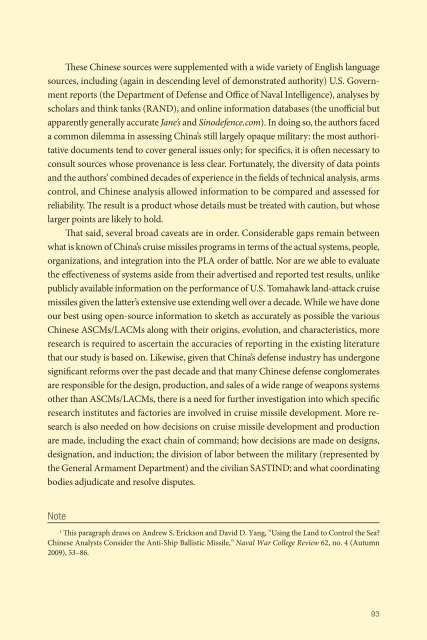You also want an ePaper? Increase the reach of your titles
YUMPU automatically turns print PDFs into web optimized ePapers that Google loves.
These Chinese sources were supplemented with a wide variety of English language<br />
sources, including (again in descending level of demonstrated authority) U.S. Government<br />
reports (the Department of Defense and Office of Naval Intelligence), analyses by<br />
scholars and think tanks (RAND), and online information databases (the unofficial but<br />
apparently generally accurate Jane’s and Sinodefence.com). In doing so, the authors faced<br />
a common dilemma in assessing China’s still largely opaque military: the most authoritative<br />
documents tend to cover general issues only; for specifics, it is often necessary to<br />
consult sources whose provenance is less clear. Fortunately, the diversity of data points<br />
and the authors’ combined decades of experience in the fields of technical analysis, arms<br />
control, and Chinese analysis allowed information to be compared and assessed for<br />
reliability. The result is a product whose details must be treated with caution, but whose<br />
larger points are likely to hold.<br />
That said, several broad caveats are in order. Considerable gaps remain between<br />
what is known of China’s cruise missiles programs in terms of the actual systems, people,<br />
organizations, and integration into the PLA order of battle. Nor are we able to evaluate<br />
the effectiveness of systems aside from their advertised and reported test results, unlike<br />
publicly available information on the performance of U.S. Tomahawk land-attack cruise<br />
missiles given the latter’s extensive use extending well over a decade. While we have done<br />
our best using open-source information to sketch as accurately as possible the various<br />
Chinese ASCMs/LACMs along with their origins, evolution, and characteristics, more<br />
research is required to ascertain the accuracies of reporting in the existing literature<br />
that our study is based on. Likewise, given that China’s defense industry has undergone<br />
significant reforms over the past decade and that many Chinese defense conglomerates<br />
are responsible for the design, production, and sales of a wide range of weapons systems<br />
other than ASCMs/LACMs, there is a need for further investigation into which specific<br />
research institutes and factories are involved in cruise missile development. More research<br />
is also needed on how decisions on cruise missile development and production<br />
are made, including the exact chain of command; how decisions are made on designs,<br />
designation, and induction; the division of labor between the military (represented by<br />
the General Armament Department) and the civilian SASTIND; and what coordinating<br />
bodies adjudicate and resolve disputes.<br />
Note<br />
1<br />
This paragraph draws on Andrew S. Erickson and David D. Yang, “Using the Land to Control the Sea?<br />
Chinese Analysts Consider the Anti-Ship Ballistic Missile,” Naval War College Review 62, no. 4 (Autumn<br />
2009), 53–86.<br />
93


